Business Process Improvement
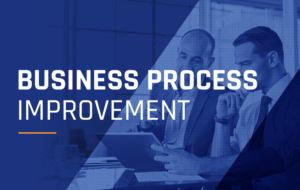
Business as usual can stand for many things. But what you don’t want it to mean is an organization that avoids development and ignores innovation — all because it has a “certain way of doing things.”
Yes, an office certainly needs fixed processes and domains to function. Departments should be set, roles should be defined and employees should have the equipment, technology and training to execute responsibilities properly. Workflows are linear and operations followed so your business, regardless of the industry it lands in, can sail on smoothly.
Yet just because you’ve been doing something a certain way for however long doesn’t mean it’s what’s best. Furthermore, outdated or stagnant business processes could actually be hurting your bottom lines and directly hindering your efficiency, which is the very opposite of what org procedures were designed to do.
With business process improvement, private and public organizations alike no longer wonder if they’re stuck in developmental dog days. They’re equipped with analysis, tools and data to transform business as usual into business that booms — and ensures they never have to look back.
What Is Business Process Improvement?
Simply put, business process improvement aims to simplify, streamline or enhance a current domain — or way of doing something — in a workplace. It is value-based, meaning any improvement comes designed to tweak and tailor the activities that directly and fundamentally contribute to the organization’s broader mission. Process improvements are also evaluative, meaning you will be able to measure the changes between “old” Process A and “new” Process B, ideally with a successful qualitative advancement.
Business process improvement also begins as a mentality but results in action. Once business process improvement project has been standardized in an office or business, the next evolution is to maximize that standardization. Goals are drafted, analyses performed and tangible action plans implemented to realize those process improvement goals — usually in the form of time, money or resources saved.
The question of how to improve a process at work affects every type of institution across every industry. That’s because every organization, from an industrial warehouse to a local government agency, likely benefits from a review and update to some aspect of their operations.
Consider the following scenarios business process improvements can directly help:
- A government health agency looking to streamline a caseload-management system for their workers to better open, manage, input and close their cases, while in the office or out in the field
- A department of transportation maximizing bus or public rideshare routes to increase ridership and profitability
- A municipality aiming to shorten response times for non-emergency constituent complaints, such as filling potholes or removing graffiti
- A manufacturing company in need of a more cohesive account receivable and accounts payable system
- A construction manager wondering how to more succinctly and efficiently staff individual sites
- A nonprofit aiming to better utilize channels of communication with its volunteers
Even more specifically, business process improvements are relevant for the following operations:
- Information Technology (IT) Process Improvements: Beyond implementing new software or computer applications to make technology-based tasks easier, IT process improvements ask the all-important why: Why is technology essential to your identity, and what value-adding ideals does it represent?
- Staff Training and Development: To ensure employees are not only well-versed and in-the-know of operational best practices, but hold buy-in and see their roles as part of the bigger picture.
- Data Inputting and Management: Free your employees and your resources from one of the most routine and perfunctory aspects of business operations so they can be dedicated elsewhere.
- Shortened Order Lead Times: Connecting the dots between individual players in your workflow while eliminating unnecessary actions, variables, bottlenecks and waste.
- Better Vendor Management: Understanding the best source of services, as well as how current vendor relationships help or hinder your own deliverables.
Evaluating, addressing and eliminating non-value-adding phases is the key to successful process improvement. At its conclusion, your organization won’t just run leaner for the sake of running leaner. By incorporating a series of specific business process improvements all tied to an end outcome, you re-focus even seemingly small tasks on achieving significant impact.
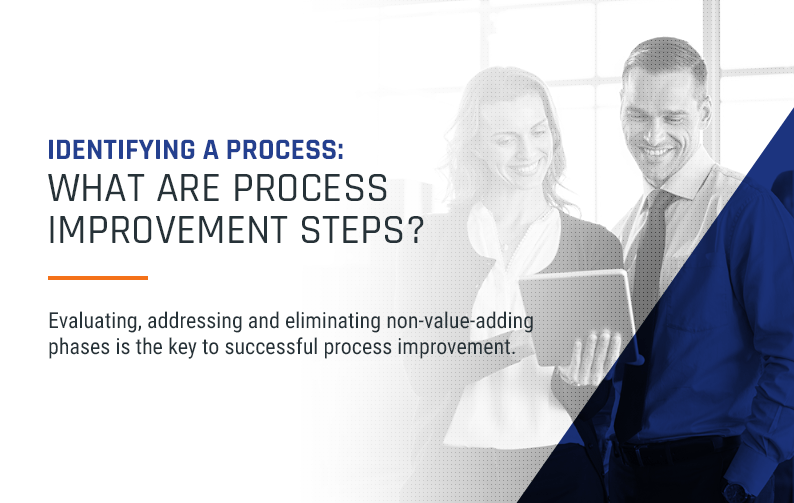
The typical steps behind starting a business process improvement plan are as follows.
1. Create a Flowchart
To begin improving processes in a business, you should first identify how your organization goes about executing specific tasks at this present moment.
Yes, this may seem like a no-brainer — but its methodic execution often isn’t. Process improvement flowcharts are a visual showcase of your present operations. It allows you to see the step-by-step, well, steps behind task execution, bringing the abstract down to the tangible and the assumed to the detailed.
Creating process flowcharts are critical first rungs in the Process Improvement step ladder.
2. Gather Current Process Data
Once a process flowchart or model is in place, you can begin to calculate operational data from it — i.e., where your business is performing at this very moment.
Use test cases and record samples of operations to generate data behind your typical workflow. It’s this data that will lend you the stepping stones to better processes, as you’ll have a numbers-backed look into what’s slow, what’s repetitive, what’s redundant or what’s frequently bottlenecked in a target domain. Some bits of information you’ll learn include:
- Activity Costs: How much does it cost your business or service to complete a process? What are a process’s expense drivers — labor, equipment, maintenance, a combination of these or something else entirely?
- Revenue Generated: What is the revenue generated from the completion of a process?
- Cycle Time: How long does it take for a process to be completed from start to finish?
- Personnel/Labor: How many employees does an activity go through before completion? What is the cost of the task’s human capital, and could it be better utilized elsewhere?
- Work Time: How much time does labor actually spend on each phase of the process?
3. Design and Implement Your Process Improvement Action Plan
If your flowchart and test cases give you insight into where business processes are performing right now, then your action plan provides insight into how they’ll perform tomorrow.
What’s more, the action plan is your roadmap to overall process improvement. You build your business process improvement initiatives around it, with numerical goals and visual modifications to cut costs, lead times, wasted personnel or any other improvement measure to drive results.
How to Improve Work Processes
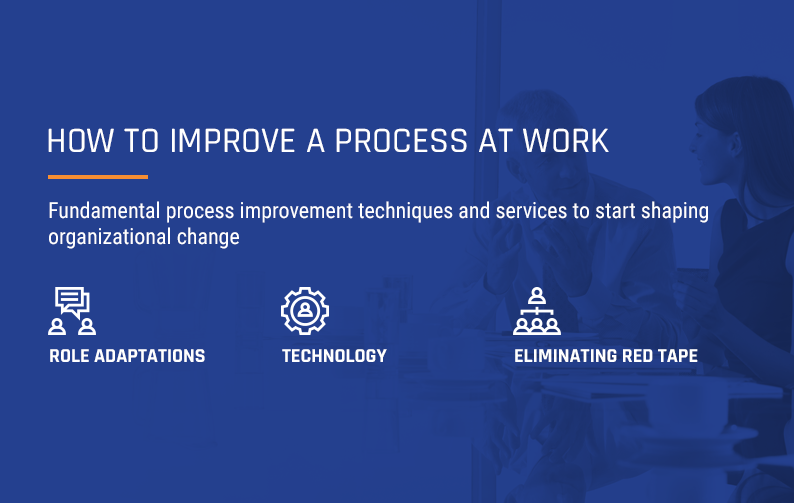 The best way to improve a business process is mostly dependent on your targeted objective. If you’re aiming to cut down on manual data entry in the office, then your improvement action plan will look different than an organization changing their payment infrastructure to be less purchase-order based and more credit-card friendly. Likewise, internal changes — like making it easier for employees to submit invoices — will take different actions than externally facing improvements, like resolving customer refund requests.
The best way to improve a business process is mostly dependent on your targeted objective. If you’re aiming to cut down on manual data entry in the office, then your improvement action plan will look different than an organization changing their payment infrastructure to be less purchase-order based and more credit-card friendly. Likewise, internal changes — like making it easier for employees to submit invoices — will take different actions than externally facing improvements, like resolving customer refund requests.
However, there are a few fundamental process improvement techniques and services to start shaping change — such as these three:
1. Role Adaptations
One of the most pertinent ways to streamline business operations is to re-shift employee roles.
Now, this doesn’t mean renaming positions for the appearance of development. And it certainly doesn’t mean eliminating responsibilities or domains someone has held for years — much less their role altogether. This is a common fear when people hear system or process changes are coming and should be addressed early by management.
Instead, role adaptations are meant to ensure employees’ day-in and day-out tasks fit higher-order strategic goals. Which is to say, workers do not have to spend the bulk of their work time on redundant tasks, manually checking for or fixing errors, navigating red tape, waiting on others in the workflow model or stuck in any other process limbo that detracts from overall efficiency.
2. Technology
IT process improvement is another way to tip the meter toward more productive office systems. For collaborative work and project management, in particular, the infusion of new software, applications or technological infrastructure helps keep every phase of a project accounted for, every stakeholder updated and every process step flowing to the next.
Remember that technology is only meant to complement human capital — not replace it. IT process improvements also come in a variety of forms:
- Automation Support: Consider how routine departmental operations could be made simpler through semi-automated programs. Tasks in finance, accounting, customer service and human resource departments are especially appropriate for automated support.
- Software Improvements: Whether it’s better digital record keeping, updated payment platforms, stronger data storage or just a more comprehensive budgeting spreadsheet, new software in the workplace can do wonders for productivity.
- IT Setup: The technological infrastructure and very digital literacy of your workforce is another principal place to analyze when it comes to process improvement techniques.
3. Eliminating Red Tape
Repetitive tasks, unnecessary oversight, slow approval processes and non-linear organizational structures are just a few banes in office work across industries. These sorts of red tape stifle workplace innovation, as they lead employees to see themselves as silent cogs in a machine rather than dynamic, fluid contributors to a higher mission.
Businesses can employ various tests and models to see where beauracratic red tape may be overshadowing rapid growth — and, conversely, where these measures are still necessary. Finding data-backed balance for your organization is critical.
Process Improvement Methodologies: Systems to Encourage Business Process Improvement Initiatives
It’s impossible to name all the process improvement methodologies that exist for businesses today. There are dozens of them, each stressing a different set of practices, beliefs and strategies for an office to reduce workflow activity costs and streamline resources.
However, for organizations in search of how to improve a process at work, the following methodologies have stood the test of time:
- Six Sigma: Dubbed by many as the “command and control approach,” Six Sigma puts quantitative outputs front and center on how to measure process improvement. Certified Six Sigma experts devise numerical targets for an organization, then set about tailoring exact, specific changes at every level of the business to drive those results, tracking and measuring updates along the way.
- Kaizen: The Kaizen methodology is also quantitative and measurable, but it centers on people and org culture rather than individual projects or departments. It encourages an iterative cycle of Plan, Do, Check and Act (PDCA), where personnel across all levels of the business have direct say in how operations are tailored, tweaked and implemented.
- ITIL® v3 Assessment: A globally renowned application for organizations to analyze how their current IT practices and infrastructure add to or detract from smooth processes, the ITIL v3 Assessment helps harmonize office technology for improved internal and external uses.
The Benefits of Process Improvement
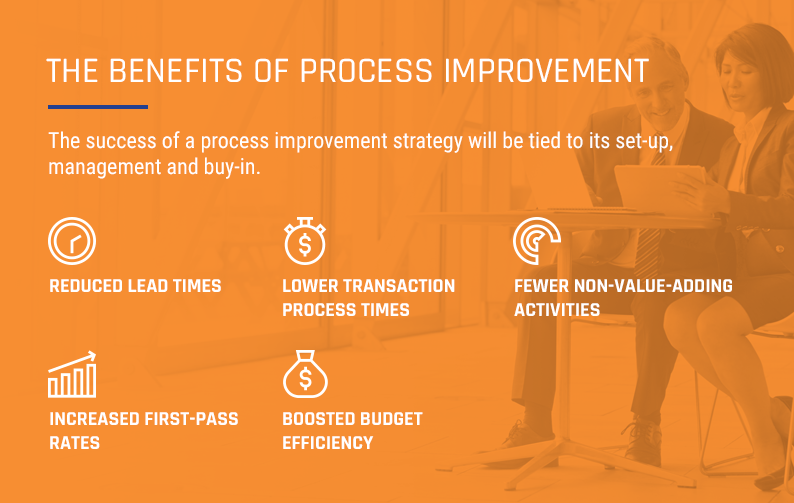
The success of a process improvement strategy will be tied to its set-up, management and buy-in. This is simply the nature of making lasting change in any workplace. Yet such effort translates into real benefits for those who can devise a clear set of goals, analyzes their workflows and makes data-backed adjustments that lead to the following five benefits.
1. Reduced Lead Times
You can cut the amount of time it takes to complete a task, execute a service or produce a product through keen process improvements. Whether it’s streamlining roles, improving technological resources, eliminating unnecessary steps or trimming process lags or interruptions, your organization can see overall growth in one of its most important performance indicators.
2. Lower Transaction Process Times
Transaction processing refers to the value-adding time spent completing the mission-critical transactions of a workflow task or service. In other words, it is the actual time spent on the target operation — not in preparation, waiting on others, checking or correcting information or the time a project or material sits in a queue.
3. Fewer Non-Value-Adding Activities
On the opposite side of the spectrum, non-value adding activities are those that contribute to higher lead times without contributing to actual task completion. This data refers to employees who are bogged down by too much lag time between workflow stages, too little or too much task oversight or oversaturated work queues that keep them from swift and simple project completion.
4. Increased First-Pass Rates
Successful process improvement also means your team can complete projects quicker and more correctly — the dream of managers and employees everywhere. High first-pass rates indicate the successful completion of an office task or activity without needing re-adjustments or re-dos — even minor ones — which then leads to increased employee agency and productivity.
5. Boosted Budget Efficiency
The best department budget is one fluid enough to adjust yet trim and tailored enough to match strategic direction. When you utilize specific process improvements, your employees, their tasks and their technology harmonize to best allocate your money.
Strategies to Keep in Mind When Implementing a New Process
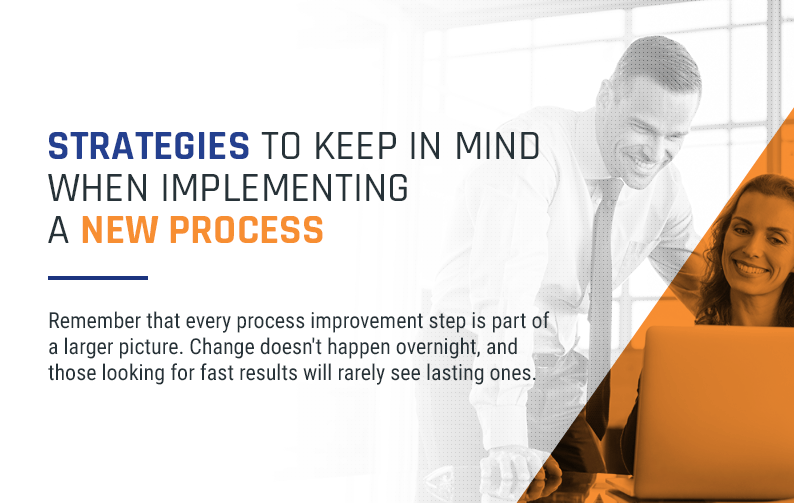
Remember that every process improvement step is part of a larger picture. Change doesn’t happen overnight, and those looking for fast results will rarely see lasting ones. Here are three tips to remember when you implement a new process at work:
1. Measure Everything
Those test cases and recorded samples of current operations? They aren’t just to keep you busy — they paint the backdrop for your exact process improvement goals. They give your organization its “before” and “after” process picture, proving the fruits of your labor with a numbers-backed difference
2. Make It a Team Initiative
Capitalize on moments for holistic buy-in from affected individuals at all levels of the organization. This will mean setting up appropriate process improvement workshops with both management and employees alike — and not just retroactively, after an action plan has gone into place and process changes are already underway. Furthermore, get ideas and feedback on current employee pain points and find ways to work those into new process pathways.
3. Don’t Assume Automation
Too many organizations still assume process improvement is synonymous with automation. While technology and IT updates are essential tools in a workplace positioning itself for a better future, they don’t define that workplace. Ensure this is supported amidst any process improvement projects or initiatives.
 When you work with Momentum, Inc., your business goals become our own. We work with you to deliver a tailored set of strategies primed to maximize your employees, your services and your industry, putting people first and turning process into progress.
When you work with Momentum, Inc., your business goals become our own. We work with you to deliver a tailored set of strategies primed to maximize your employees, your services and your industry, putting people first and turning process into progress.
Explore our approach to Business Process Improvement services, or get in touch directly at (717) 214-8000 to see what momentum we can create for you.
 Tap to email
Tap to email
